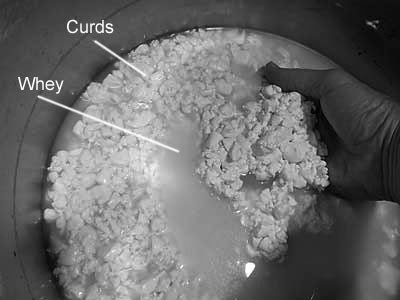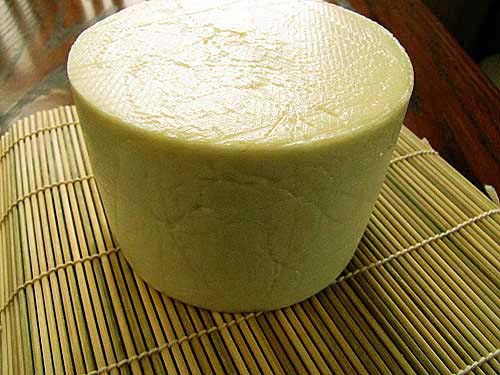 |
| Merryl visiting Ricki at her home in Ashfield, MA |
Merryl Winstein teaches a wide range of cheesemaking classes year round, both on weekends and during the week – some full days and some half days. In other words, she teaches a lot! She’s been offering classes for over 7 years out of her home in Webster Groves, a suburb of St. Louis.
It’s all thoroughly explained at her website. There is also a You Tube video about her urban “farm” called KETC/Living St. Louis/Goat Lady (shown at the end of this article). And, you can see her on her Facebook page.
Merryl is able to raise goats and chickens in a suburban neighborhood because the city ordinances allow for the raising of farm animals. So, she begins her classes by demonstrating milking and discussing proper milk handling procedures.
When her students have completed a class, she sells them both the raw milk and the supplies they need to go home and make their own cheese. (Missouri is one of 15 states where it is legal to sell raw milk at the source)
 |
| Goats on their stands |
Denmark, 1970. I was 14 and raised on Kraft Singles, but the phenomenally strong flavors of Tilsit, brown crusted firm Havarti, and gooey Esrom wowed me. Later, in Canada, there were English cheeses – Leicester, Wensleydale, and more, each more enchanting than the next. Then in 1993, I began raising dairy goats in my urban St. Louis, Missouri backyard. Visions of homemade, delicious versions of those memorable cheeses were about to become real!
 |
| Goats being goats |
Whoops! The few written directions I found confused me. Cheesemaking demonstrations taught me faulty methods that didn’t work. My toddlers interrupted. Cheese stayed un-eaten in the fridge because it tasted bad. As the kids grew, I tried again, with fewer interruptions. But it still didn’t make sense. Why did some breakthrough cheeses taste terrific, while the rest were trouble? I’d tasted cheese made by other goat breeders; all of it tasted weird. I started concluding that’s just the way home-made cheese is.
Eventually, for no reason, my cheeses improved. Since I raised the only dairy goats within dozens of miles, people asked me to teach them cheese making. Then Barbara Kingsolver’s book, Animal, Vegetable, Miracle hit the stands; instantly, requests for cheesemaking classes drowned our answering machine!
Teaching cheese making is great fun, yet I grew more frustrated and embarrassed each time I said “I don’t know why this happens.” Why did the curds from store-bought low-temperature pasteurized milk turn out differently every time? Why didn’t more of the cheese taste really good? What did the written directions in books actually mean?
 |
| Neighbors holding baby Saanens |
When someone told me that cheese expert Jim Wallace taught great cheesemaking classes in Massachussetts, I signed up. After so many years of making cheese wrong, it was easy to spot what would make it turn out better.
Then, I finished the three-week class plus additional seminars at VIAC (Vermont Institute for Artisan Cheese in Burlington, VT) and simply plugged it in. Studying constantly, listening, learning, teaching, and making terrific goat and cow cheeses we love to eat – that’s really rewarding.
But now my greater passion is passing on good cheesemaking skills to others…
 |
| Merryl’s son, David, a few years ago |
 |
| Checking temperature of curds |
After learning a complete array of cheesemaking methods in one of my classes, people are eager to tackle making any sort of cheese at home.
First, I milk the goats as everyone watches. “What’s the best breed?” “Why does the milk from this goat taste so much sweeter and creamier than the next?” They see my milk safety practices, and we compare those to the protocols used in a larger commercial dairy.
 |
| Workshop participants |
Then, we learn proper care and cooling of the milk. You’d be surprised how many people don’t cool their milk correctly, resulting in failed cheese. Of course, the warm, strained milk is perfect for pouring straight into the cheese pot. Otherwise, an icy water bath cools it to 50°F within a half-hour.
 |
| Participant proud of her cheese |
 |
| Participant stirring milk |
But warm jars or cans of milk popped into the fridge or freezer will hardly reach 70°F two hours later, encouraging abundant bacterial growth. Although the milk may taste OK for a few days, it will be too acid for good cheesemaking. I encourage people to ask how their farmer cools the milk – it’s very important.
Then, it’s on to cheesemaking using both goat and cow milk. In my Half-Day Cheese Making Class, we make soft spreadable Chevre, Feta, Stirred-Curd Cheddar, Yogurt and Ricotta. We often make Sour Cream as well.
 |
| Participant whisking curds |
 |
| “Hands-on” workshop |
My All-Day Cheese Making Classes cover four contrasting cheesemaking methods per day, or eight methods for a weekend (people choose one day or both). On one day, we create Chevre, Camembert, Traditional Cheddar and an Alpine Swiss cheese. On the other weekend day, we make Blue Cheese, Traditional Scamorza/Mozzarella, Ricotta, and Kefalotyri, a delicious Greek hard cheese tasting similar to Asiago.
 |
| Blue goat cheese |
We start the process. Packets of bacterial starter culture, I explain, are a modern stand-in for traditional overnight milk ripening. Rennet is stirred in. Then, “Oohs” and “Ahhs” of wonder accompany the sudden gelling of the milk at the “flocculation point”. We carefully watch for the correct texture which signals cutting time. As time goes by, the curds we have tended, warmed and stirred for so long finally feel just right, and it’s time to drain and press. All along, the pH meter has verified the changes in aroma and texture we’ve observed.
 |
| Stretching Mozzarella |
 |
| Scamorza |
Then, we try out luxurious pre-made presses, and thriftier alternatives which work great too. Finally, we see astonishingly simply aging arrangements which are fine substitutes in case you don’t own an actual cave.
After seeing, feeling and comparing the processes for so many cheeses, everyone feels confident that they can go home and make their favorite types of cheese!
 |
| Blue goat cheese |
Cheesemaker and Cheesemaking Instructor, St. Louis, MO
www.cheesemakingCLASS.com phone 314-968-2596



















































































































































